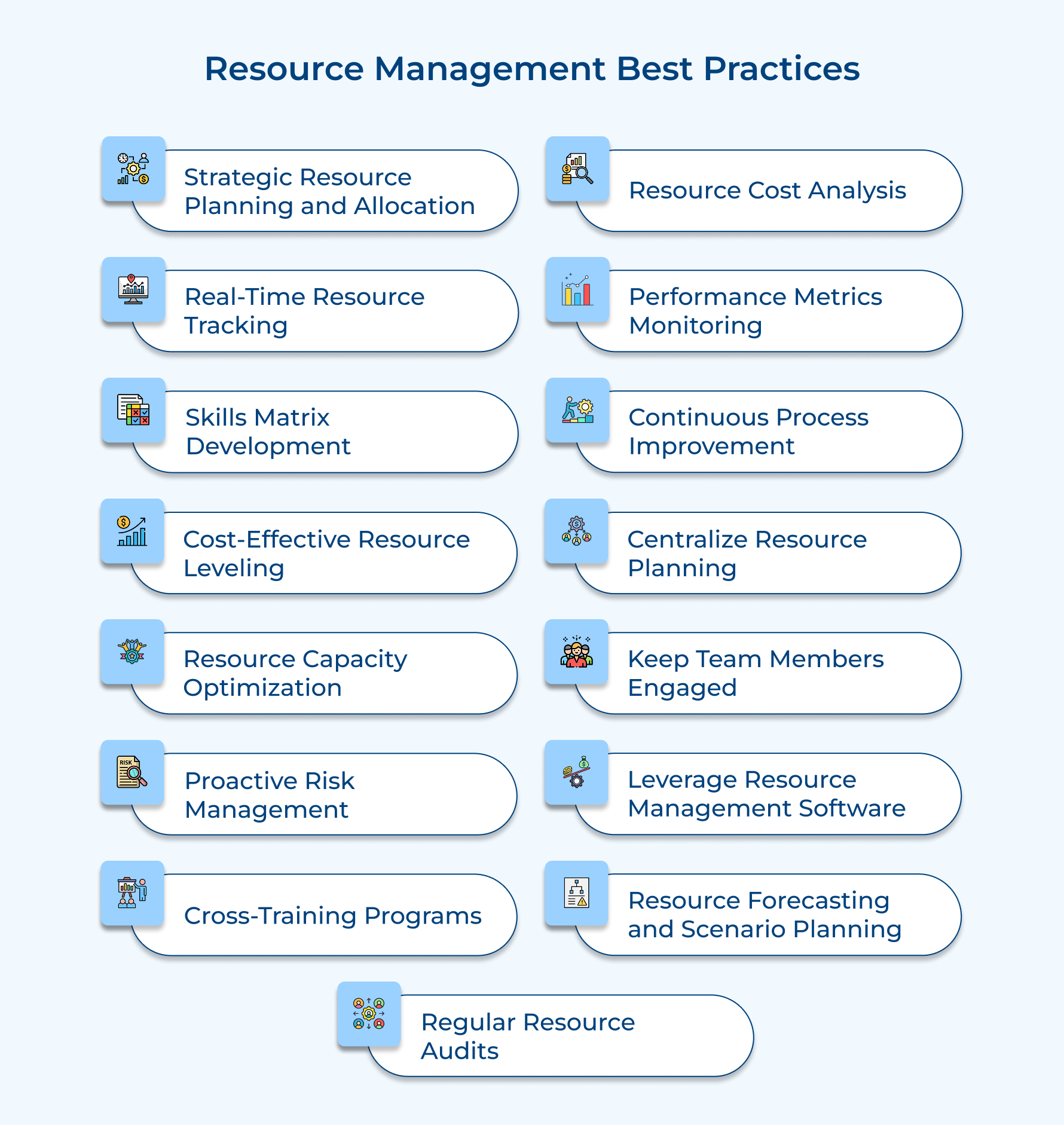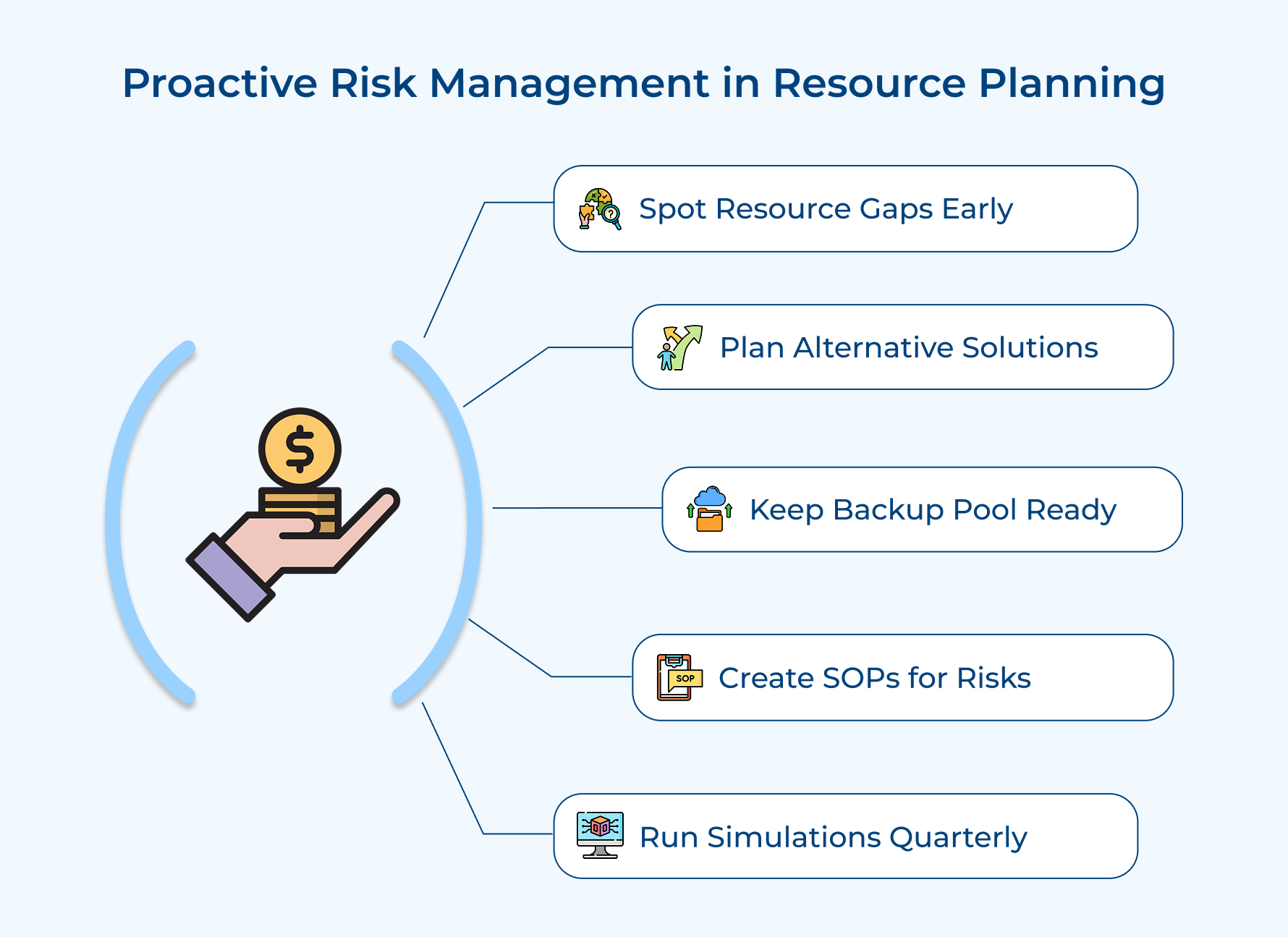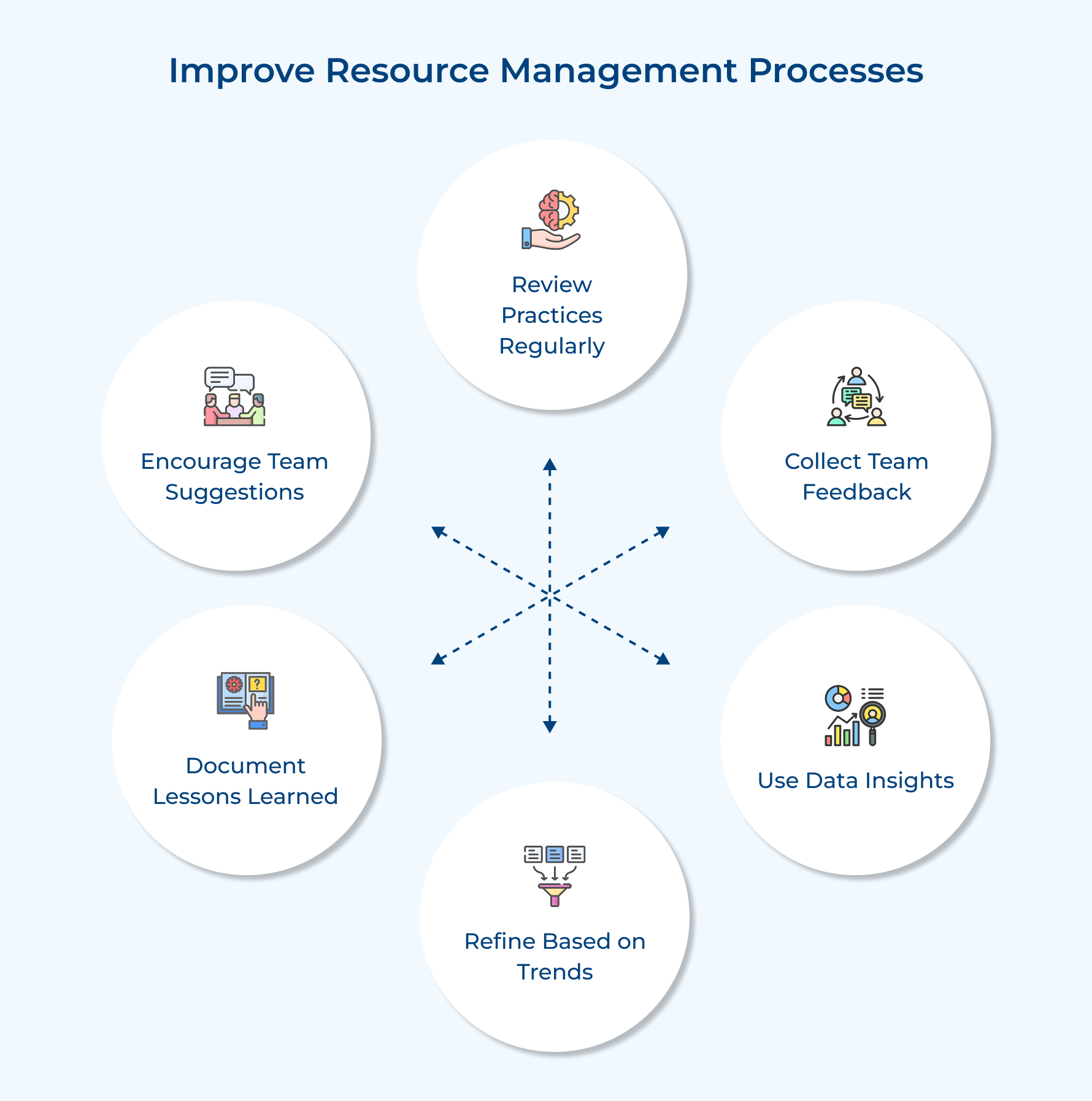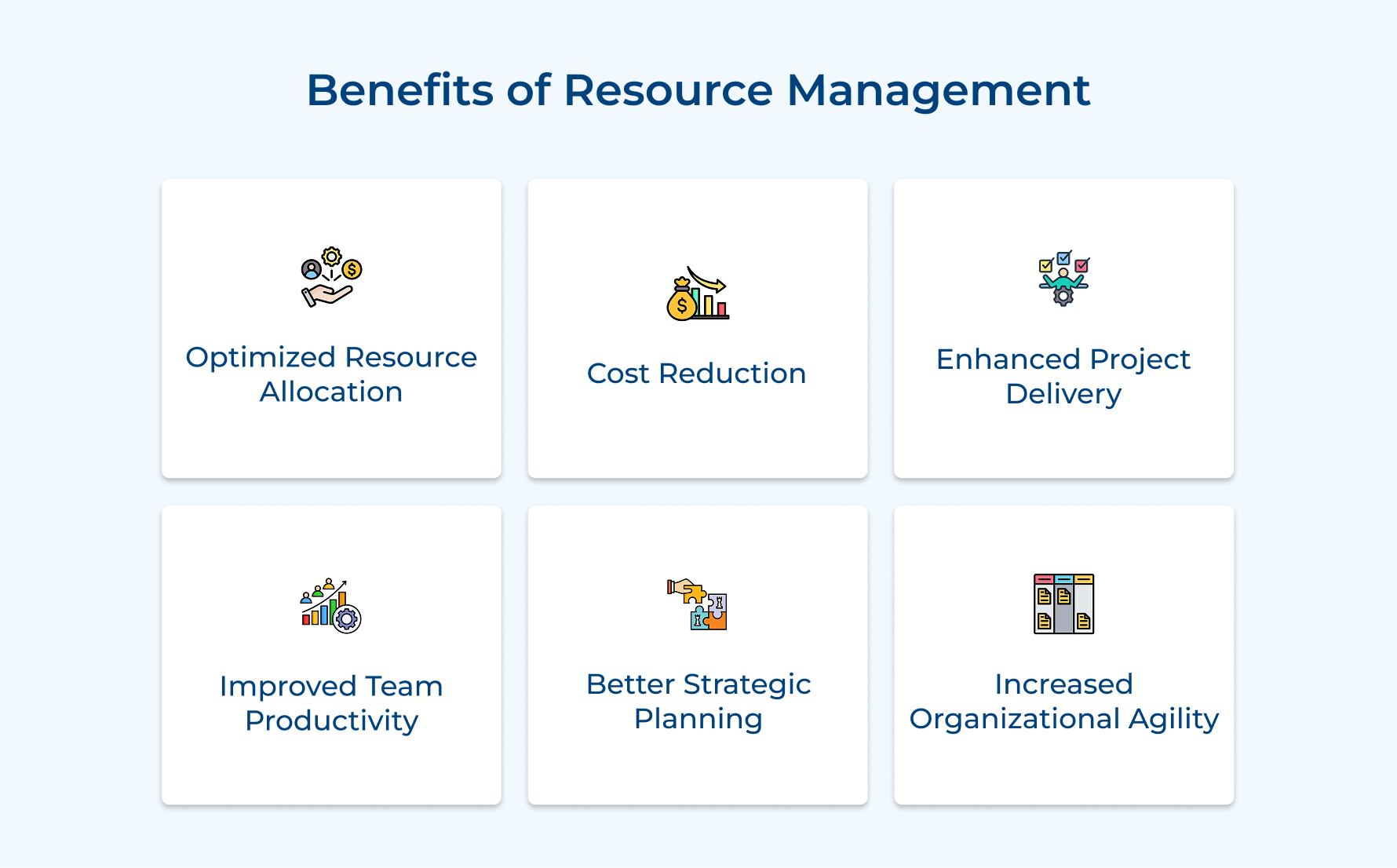15 Ultimate Resource Management Best Practices for Success

Key Highlights:
- Optimize resources by balancing workloads, preventing conflicts, and reducing costs to enhance efficiency while driving profitability.
- Leverage real-time tracking and software tools to ensure accurate allocation, minimize delays while seamlessly adapting to changing project demands.
- Resource management best practices boosts team productivity through cross-training and continuous improvement strategies.
Struggling to manage resources effectively? Poor allocation leads to bottlenecks, missed deadlines, and wasted potential, hurting both productivity as well as profits.
Improper resource planning leads to projects becoming chaotic, teams feeling overwhelmed, and financial resources go underutilized. Resource constraints and time constraints slow progress, causing delays along with inefficiencies.
This blog will dive into the best practices for managing project resources. Learn how to optimize workflows, enhance collaboration, and overcome constraints to maximize success!
Maximizing Profit with 15 Resource Management Best Practices
Effective resource management is key to boosting profitability. Discover these best practices, from resource smoothing to optimizing your resource management process.
1. Strategic Resource Planning and Allocation
Effective resource planning is the key to balancing project demands with limited resources. A strategic approach ensures optimal utilization, cost savings, and smooth execution.
- Optimize resource utilization: Systematically identify, allocate, and manage resources to align with business goals as well as project needs.
- Avoid resource conflicts: Balance limited resources across multiple projects to prevent bottlenecks and inefficiencies.
- Reduce costs & improve outcomes: Smart planning ensures projects have the right resources at the right time, enhancing performance.
- Create a comprehensive plan: Define resource requirements, availability, and allocation for seamless execution.
- Leverage forecasting tools: Predict future resource demands and establish clear allocation priorities.
- Adapt & adjust: Regularly review plans to stay ahead of shifting project needs and constraints.
Tips:
- Develop a centralized resource calendar showing all project timelines and resource commitments, updating it weekly to maintain accuracy.
- Create resource allocation matrices that match skills to project requirements, including buffer time for unexpected demands.
2. Real-time Resource Tracking
Imagine managing a project without knowing who’s available or what resources are being used—it’s like flying blind. Real-time resource tracking keeps you in control by continuously monitoring resource utilization, availability, and performance using automated systems.
Not having real-time tracking can lead to teams working with outdated information. This translates to double bookings, underutilized assets and last-minute chaos.
To stay ahead, invest in automated tracking tools that provide instant visibility. Set up dashboards to monitor resource status at a glance and establish regular reporting cycles to spot trends as well as optimize allocation before bottlenecks arise.
Tips:
- Set up automated alerts for resource utilization thresholds to identify potential overallocation or underutilization early.
- Implement daily resource status updates through quick team check-ins or automated time-tracking tools.
3. Skills Matrix Development
Ever struggled to find the right person for a project? A skills matrix can be a game-changer. It’s a visual tool that maps out your team’s expertise, certifications, and competencies, giving you a clear picture of the talent within your organization.
When there isn’t proper skills inventory, you risk assigning tasks to the wrong people. Hence, leading to inefficiencies and missed deadlines. A skills matrix helps prevent this by ensuring that the right talent is matched to the right projects.
Create detailed skill profiles for each team member and update them regularly. Use the matrix to guide project staffing, spot training needs, and fill skill gaps through upskilling or hiring.
Tips:
- Schedule quarterly skills assessments with team members to update their competency levels and new skills acquired.
- Create skill heat maps showing expertise distribution across teams to identify areas needing development.
4. Cost-effective Resource Leveling
Ever felt like your team is drowning in work one week and twiddling their thumbs the next? That’s where resource leveling comes in. It helps balance workloads by adjusting project schedules and resource allocation, preventing burnout while keeping costs in check.
When resources are unevenly distributed, employees face intense pressure during peak times and long idle periods in between. This leads to unnecessary overtime costs, missed deadlines, and stressed-out teams. Resource leveling helps avoid these pitfalls.
Analyze resource demands across projects, spot over- or under-allocation, and adjust schedules accordingly. Use resource management tools to test different scenarios and find the best way to distribute work smoothly.
Tips:
- Implement a rolling wave planning approach, reviewing and adjusting resource allocations every two weeks.
- Establish resource utilization thresholds (e.g., 80% maximum) to maintain flexibility for unexpected demands.
5. Resource Capacity Optimization
Capacity optimization ensures that resources are used efficiently without overloading or underutilizing them. For example, if a design team is stretched thin, reallocating tasks or hiring freelancers can balance the workload.
Regularly track utilization, compare it with targets, and adjust as needed. With smart planning, you’ll avoid burnout, meet deadlines, as well as keep operations running smoothly.
Tips:
- Create capacity utilization reports showing actual vs. planned usage, reviewing them monthly to identify trends.
- Develop capacity buffers of 15-20% for critical resources to handle unexpected demands.
6. Proactive Risk Management
Resource risks can throw projects off track, causing delays and unexpected costs. A proactive approach helps you stay ahead of challenges while keeping things running smoothly.
- Identify potential risks early: Spot resource shortages, skill gaps, or scheduling conflicts before they become problems.
- Develop mitigation strategies: Plan alternative solutions, like cross-training employees or securing backup vendors.
- Maintain contingency plans: Keep a list of contractors or temp staff ready for quick scaling when needed.
Tips:
- Develop and maintain a backup resource pool list, updating it monthly with availability as well as contact information.
- Create standard operating procedures for common resource risk scenarios, testing them quarterly through simulations.
7. Cross-training Programs
Cross-training empowers your team to step into different roles when needed, keeping projects on track and reducing dependency on a few key individuals.
- Identify essential skills: Pinpoint critical roles that need backup coverage to prevent bottlenecks.
- Pair up team members: Let experienced employees mentor others through hands-on learning.
- Rotate responsibilities: Give employees real-world practice to build confidence and adaptability.
- Track progress: Use skill assessments or certifications to measure improvement and readiness.
Tips:
- Create mentorship pairs within teams, rotating roles every quarter to ensure knowledge transfer.
- Maintain cross-training matrices showing primary and backup capabilities for each critical skill.
8. Resource Cost Analysis
Keeping track of resource costs is essential to staying within budget and maximizing profitability. A clear cost analysis helps you spot inefficiencies and cut unnecessary expenses.
- Track all expenses: Monitor labor, training, equipment, and overhead costs to get a complete picture.
- Compare actual vs. budgeted costs: Identify where you’re overspending or saving.
- Optimize resource allocation: Use insights to adjust spending and improve cost efficiency.
Tips:
- Create monthly cost performance reports comparing planned vs. actual resource costs across projects.
- Establish cost benchmarks for different resource types and regularly review variances.
9. Performance Metrics Monitoring
How do you know if your resources are being used effectively? Tracking performance metrics is key! Imagine a marketing agency measuring designer productivity—if one completes 10 creatives a week while another struggles with 5, it signals a gap.
You can spot inefficiencies, recognize top performers, as well as refine strategies by monitoring KPIs like workload balance and project turnaround time. Set clear KPIs, track progress, and adjust allocations to keep everything running smoothly.
Tips:
- Develop balanced scorecards for each resource category, reviewing them monthly with team leads.
- Set up automated dashboards showing real-time performance metrics against established targets.
10. Continuous Process Improvement
To keep resource management effective, you need to refine processes continuously. What worked last year might not work today!
- Review regularly: Set up routine check-ins to evaluate current resource management practices.
- Gather feedback: Talk to your team about what’s working and what’s not.
- Make data-driven improvements: Analyze trends and refine processes accordingly.
- Document best practices: Keep track of lessons learned to improve future strategies.
Tips:
- Schedule quarterly process review sessions with key stakeholders to identify improvement opportunities.
- Create an improvement suggestion system where team members can submit ideas anytime.
11. Centralized Resource Planning
Centralized resource planning consolidates all resource-related information and decision-making into a single system or department, ensuring consistent management practices.
Centralization improves coordination, reduces conflicts, and enables better resource optimization across the organization.
Implement a central resource management system, standardize planning processes, and establish clear communication channels for resource requests as well as allocation.
Tips:
- Create a central resource management office with clear authority and responsibility.
- Implement weekly resource planning meetings with all project managers to coordinate allocations.
12. Keep Team Members Engaged
Employee engagement focuses on maintaining high levels of motivation, job satisfaction, and commitment among team members through recognition, growth opportunities as well as positive work environment.
Create engagement programs combining professional development, recognition systems, and regular feedback mechanisms. Monitor satisfaction levels and address concerns proactively.
Tips:
- Schedule monthly one-on-one meetings with team members to discuss career goals and challenges.
- Implement a structured recognition program with both monetary and non-monetary rewards.
13. Leverage Resource Management Software
Managing resources manually can be overwhelming and prone to errors. That’s where resource management software comes in. Here’s how it helps:
- Automates planning & tracking: No more spreadsheets! Software streamlines resource allocation and utilization.
- Boosts accuracy & efficiency: It reduces human errors and speeds up decision-making.
- Provides real-time insights: Get clear visibility into workloads and performance.
- Enhances forecasting: Predict future resource needs and optimize usage.
- Seamlessly integrates: Choose software that works well with your existing tools for smooth operations.
Tips:
- Conduct thorough user training sessions and create quick reference guides for common tasks.
- Set up automated reporting schedules to ensure consistent monitoring and analysis.
14. Resource Forecasting and Scenario Planning
Resource forecasting helps you stay ahead by predicting future resource needs and planning for different scenarios.
- Avoid shortages & excess capacity: Accurate forecasting ensures you have just the right resources when needed.
- Use historical data & trends: Analyze past projects to predict future demands.
- Plan for multiple scenarios: Prepare for best-case, worst-case, and realistic situations.
- Build contingency plans: Stay flexible with backup strategies for unexpected changes.
Tips:
- Create quarterly resource demand forecasts with best-case, worst-case, and most likely scenarios.
- Maintain a resource buffer pool that can be quickly deployed based on scenario triggers.
15. Regular Resource Audits
A resource audit is like a health check for your team and tools. Imagine a company facing project delays despite having enough people. An audit reveals that some employees are overworked while others have little to do.
Productivity improves and deadlines are met by balancing workloads. Regular audits help identify inefficiencies, ensure resources are used wisely, and keep everything running smoothly.
Tips:
- Develop a comprehensive audit checklist covering all aspects of resource management.
- Schedule bi-annual deep-dive audits with follow-up reviews every quarter.
Benefits of Using Resource Management Best Practices
Managing resources effectively is the key to smooth project execution, cost savings, and a motivated team. Here’s how smart resource management drives success.
Optimized Resource Allocation
When the right people with the right skills are assigned to the right tasks, work flows smoothly. No more last-minute scrambles or unnecessary bottlenecks, just streamlined project delivery with fewer hiccups.
Cost Reduction and Control
Good resource management isn’t just about efficiency; it also saves money. By distributing workloads better, companies reduce overtime costs, make the most of existing talent, and minimize waste through smart planning.
Enhanced Project Delivery
Ever had a project delayed because of resource conflicts? With proper planning, teams can stick to timelines, maintain quality, and avoid last-minute surprises. Smooth allocation means fewer delays and more reliable outcomes.
Improved Team Productivity
Balanced workloads mean less stress and burnout. When everyone knows their role and has the right amount of work, they stay motivated as well as perform better—without feeling overwhelmed or underutilized.
Better Strategic Planning
With a clear view of available resources and future capacity, businesses can make better long-term decisions. Need to hire, train, or shift priorities? Proper resource management gives leadership the insights they need.
Increased Organizational Agility
Things change—new projects pop up, priorities shift. Organizations that manage resources well can quickly adjust, moving people where they’re needed most without disrupting ongoing work.
Transforming Business with Resource Management Practices
Mastering resource management best practices unlocks your organization’s true potential. When best practices are put into place, growth and profitability become natural outcomes. The efficient use of resources leads to better outcomes, smoother operations, and a stronger, more resilient business.
Streamlining processes, optimizing team collaboration, and eliminating waste enable your company to thrive even in a competitive market. Embrace these practices to propel your company forward, improve performance, and achieve lasting success, all while creating a culture of continuous improvement.
Limit time — not creativity
Everything you need for customer support, marketing & sales.
Neeti Singh is a passionate content writer at Kooper, where he transforms complex concepts into clear, engaging and actionable content. With a keen eye for detail and a love for technology, Tushar Joshi crafts blog posts, guides and articles that help readers navigate the fast-evolving world of software solutions.



